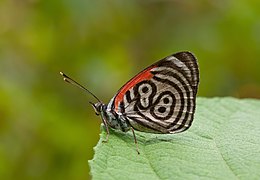Portal:Venezuela
The Venezuela Portal Venezuela, officially the Bolivarian Republic of Venezuela, is a country on the northern coast of South America, consisting of a continental landmass and many islands and islets in the Caribbean Sea. It comprises an area of 916,445 km2 (353,841 sq mi), and its population was estimated at 29 million in 2022. The capital and largest urban agglomeration is the city of Caracas. The continental territory is bordered on the north by the Caribbean Sea and the Atlantic Ocean, on the west by Colombia, Brazil on the south, Trinidad and Tobago to the north-east and on the east by Guyana. Venezuela is a presidential republic consisting of 23 states, the Capital District and federal dependencies covering Venezuela's offshore islands. Venezuela is among the most urbanized countries in Latin America; the vast majority of Venezuelans live in the cities of the north and in the capital. The territory of Venezuela was colonized by Spain in 1522 amid resistance from Indigenous peoples. In 1811, it became one of the first Spanish-American territories to declare independence from the Spanish and to form part of the first federal Republic of Colombia (Gran Colombia). It separated as a full sovereign country in 1830. During the 19th century, Venezuela suffered political turmoil and autocracy, remaining dominated by regional military dictators until the mid-20th century. From 1958, the country had a series of democratic governments, as an exception where most of the region was ruled by military dictatorships, and the period was characterized by economic prosperity. The 2024 presidential election were not recognized by the Carter Center and Organization of American States due to the lack of granular results, and disputed by the opposition, leading to protests across the country. (Full article...) Selected article - Ciudad Bolívar (Spanish pronunciation: [sjuˈðað βoˈliβaɾ]; Spanish for "Bolivar City"), formerly known as Angostura and St. Thomas de Guyana, is the capital of Venezuela's southeastern Bolívar State. It lies at the spot where the Orinoco River narrows to about 1 mile (1.6 km) in width, is the site of the first bridge across the river, and is a major riverport for the eastern regions of Venezuela. Historic Angostura gave its name to the Congress of Angostura, to the Angostura tree, to the House of Angostura, and to Angostura bitters. Modern Ciudad Bolívar has a well-preserved historic center; a cathedral and other original colonial buildings surround the Plaza Bolívar. (Full article...) Selected picture Mount Kukenán, in the Guiana Highlands
Selected biography - Manuel Trujillo Durán (8 January 1871 – 14 March 1933) was a Venezuelan photographer who pioneered film in Venezuela. Trujillo was most successful as a photographer, though he dabbled in other industries and is best remembered for his connections to the fledgling film industry in Venezuela. He became one of the first people from Latin America to learn how to show films; he was thought for many years to be the director of Venezuela's first films, and traveled through Venezuela and Colombia with projectors to introduce cinema to this part of the South American continent. (Full article...) In this month...
Did you know (auto-generated) -
Selected list -The University City of Caracas is a World Heritage Site in Caracas, Venezuela. It is a functional university campus for the Central University of Venezuela, as well as home to 108 notable works of art and famous examples of creative architecture. Many works of art are modernist and mosaic. The campus was designed by architect Carlos Raúl Villanueva, who oversaw much of the construction and design work, with the artwork overseen by Mateo Manaure. Villanueva primarily enlisted artists who were either European or had European influences – Villanueva himself had been inspired for the campus design in Paris – including members of Los Disidentes, a group of Venezuelan artists who left for Europe to break from the Mexican mural tradition. Some artists did not initially want to work on the project, as they were opposed to the military dictatorship in place in Venezuela at the time, but French artist Fernand Léger encouraged them to participate by saying that "dictatorships pass but art remains"; part of Villanueva's intention was unity. Latin American art scholar Monica Amor wrote that Villanueva's Synthesis of the Arts philosophy, inspired by an André Bloc approach, "advocated a strong humanist approach to urban issues of reconstruction and social healing after the devastation of World War II." Amor noted that debate surrounding the dictatorship's funding of the project, and its realization in this context, persists into the 21st century. (Full article...) Current events
More did you know...
TopicsCategoriesRecognized content
Featured articlesGood articles
Featured pictures
New articlesThis list was generated from these rules. Questions and feedback are always welcome! The search is being run daily with the most recent ~14 days of results. Note: Some articles may not be relevant to this project.
Rules | Match log | Results page (for watching) | Last updated: 2024-12-24 22:20 (UTC) Note: The list display can now be customized by each user. See List display personalization for details.
Things you can doWikiProjects
Related portalsAssociated WikimediaThe following Wikimedia Foundation sister projects provide more on this subject:
Discover Wikipedia using portals |




































